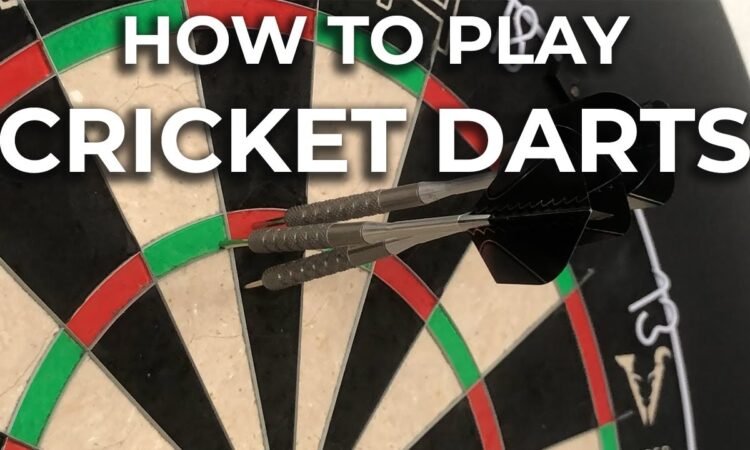
This game of Cricket Darts, which combines strategy, skill plus a bit of math is very popular among darts game fans. It involves players hitting certain numbers as opposed to simply scoring highest in other traditional dart games. Consequently, this not only encourages better play but also provides varied and critical engagements within individual players’ homes, social clubs as well as global competitions. Contrary to what many people think about the name “Cricket” not being associated with any sporting activity, it has been derived from its way of scoring that is based on opening and closing scores just like in cricket pitches. Hence this scoring style makes it more interesting because you have to think outside the box thus resulting in more excitement.
Equipment Needed
To enjoy cricket darts, the following equipment is imperative: A standard bristle dartboard is used in cricket darts. The center (bullseye) should be situated at a distance of 5 feet 8 inches (1.73 meters) from the floor. The usual set of three darts is used by each player. The common materials for making these are brass and tungsten. Players must stand within the throw line (oche) for throwing purposes. This should be 7 feet 9.25 inches (2.37 meters) away from the dartboard face. This is a special board where one can jot down their scores using chalk or markers if the traditional scoreboards are being utilized. Make sure that your equipment is in good shape because using damaged darts or an old board may not only affect the game but also lead to serious accidents as well.
Setting Up the Game
These are the steps to follow before playing a game of Cricket Darts:
- Hang up the dartboard: The board should be attached to the wall properly and at a height that corresponds to 5 feet 8 inches.
- Mark the throwing line: You can use tape or get an oche that is high enough, to make a clear demarcation of where you are supposed to stand from the dartboard.
- Prepare the scoreboard: If it’s a special Cricket scoreboard see if everyone can see it. In case you have decided to utilize a whiteboard then draw a grid-like structure that has the numbers 20,19,18 and so on vertically while the horizontal sections have names of the respective players or teams.
- Decide who plays first: A coin toss can be used for this purpose or ask all players to throw one dart at the bullseye. The individual whose dart lands closest to the bullseye begins gameplay.
Basic Rules of Cricket Darts
Cricket Darts is played with the following basic rules:
- This is about “closing” all of the target numbers (20, 19, 18, 17, 16, 15, and bullseye) with the greater point score.
- Closing of numbers: For a player to close a number, he/she needs to hit it thrice. The outer ring counts as double (two hits) while the inner ring counts as triple (three hits).
- Scoring: After closing a number, players can use it to score points until their opponents do the same.
- Winning the game: Once one player has closed all numbers including bullseye and has equal or more points than the other player then they win the game.
- Turns: Each player throws three darts on his/her turn which is passed then to another player
When a dart bounces back from off_board it does not count nor can be rethrown.
Scoring in Cricket Darts
In cricket darts, scoring comprises both closing numbers and earning points.
- Marking hits: When a player hits the number they are aiming at, it is indicated on the score sheet. Generally, one hit is denoted by a slash (/), two hits with an X, while three hits (closing the number) are marked with a circle (O).
- Points scoring: When a player has closed an area, every following strike on that part will earn its original value until the opponent closes it as well (e.g. hitting one single 20 earns back 20 points).
- Bull’s Eye: The outside bull’s eye holds 25 points while 50 are found in the inside one or double bull’s eye. To complete bull’s eye you only need to make two hits; (outer counts as one; inner counts as two).
- Keeping scores: Scores are recorded cumulatively. For instance, if a player scores 60 points after closing 20 such that it corresponds to three tens, their score goes up by 60.
Read Also : Home of West Indies Cricket: Barbados’ Iconic Stadium
Strategies for Winning
Successful Cricket Darts players employ various strategies:
- Point building: Some players end up focusing on the fast closing of high-value numbers to score points.
- Defensive play: Others prioritize closing numbers that their rivals have already closed to prevent them from scoring.
- Bullseye tactics: The bullseye can be a game-changer. Closing it early may give a player a significant advantage.
- Order of closing: Generally, players begin with higher values (20, 19, 18) because they give more potential points.
- Pressure throws: When a rival is near to winning, targeting his unclosed numbers can make him change his focus.
- Mathematical awareness: Keep track of scores and required hits to plan your throws effectively.
Variations of Cricket Darts
Several variations of Cricket Darts add new dimensions to the game:
- Cut-Throat Cricket: The opponent is scored bites with the lowest score being victorious.
- Random Cricket: In every game, certain numbers are randomly chosen from the pool.
- Wicket Cricket: Players start with a certain number of “wickets” (lives), which they lose when they fail to score during a turn.
- Ghost Cricket: A one-player game against an imaginary competitor who closes one number every round.
- Master Cricket: Added target numbers such as 14 and 13.
These options can provide more excitement and challenges for your Cricket Darts competition.
Etiquette and Safety
For everyone’s pleasure, it is crucial to comply with rules of etiquette and safety measures:
- Respect your fellow contestants: Steer clear of any distracting movements or sounds while hauling.
- Be patient before your turn: Approach the board only after the last player has removed his/her darts.
- Honesty in scoring: Always tell the truth concerning personal scoring as well as hitting the board.
- Handle darts with care: One must not throw darts when other people are close to it.
- Keep things in order: Make it a habit to check on damages from time to time on both dartboards and darts themselves;
- Sporting spirit: Recognize winners without too much outcry from fans;
- Drink sensibly: When playing inside pubs always keep in mind that alcohol can adversely affect reasoning abilities and hand-eye coordination.
Improving Your Cricket Darts Skills
To improve your cricket darts skills:
- Do regular practice: The importance of consistency in improvement can not be emphasized enough.
- Pay attention to your stance and throw: Create a throwing motion that feels good every time it is repeated.
- Aim at specific numbers: Spend time targeting certain numbers to enhance precision.
- Mental game: Focus on managing anxiety and concentrating better in critical moments of the game.
- Learn from masters: Look, see, and replicate how seasoned players do it.
- Participate in a league: Playing against other players can help you improve faster.
- Use different equipment types: Experiment with different weights and designs of darts until you find what feels right for you.
Organizing a Cricket Darts Tournament
A Cricket Darts contest that you host is one way of creating a bond among players.
- Set clear guidelines: Choose the type of competition (elimination, round-robin, etc) as well as any other specific regulations.
- Make the venue ready: You should have enough boards and space for everyone taking part.
- Create a timetable: Plan match times and assign boards ahead of time.
- Elect referees: So that matches can be watched over by neutral parties who will also help in settling disagreements.
- Offer prizes: This will make them eager to participate if they know there’s something they could take home after winning
- Promote it: Use electronic platforms to notify potential attendees about this event
- Health precautions: Follow any health-related standards that may apply in such cases too.
Conclusion
The ideal combination of abilities, tactics as well as communalizing is provided by cricket darts. Understanding the guidelines and refining your abilities can enhance the fun you can derive from it, irrespective of whether you are playing with friends casually or at tournaments. Always remember that bothering to practice persistently and taking lessons from every individual attempt is associated with making advancement. So get together all your darts and put up the board so that you may appreciate these challenging yet rewarding cricket darts!
Frequently Asked Questions (FAQ)
Q1: How do Cricket Darts differ from ordinary darts?
A: Cricket Darts involves hitting certain numbers such as 20, 19,18,17, 16, and 15 (in addition to bullseye) thereby incorporating both closing figures and scores whereas in regular darts it is simply about achieving the highest point possible.
Q2: How many players can participate in Cricket Darts?
A: Two players or two teams can engage in a Cricket Darts match. The game is most commonly played as a one-on-one affair or with two sets of two players each.
Q3: In what sense does it mean when someone talks about “closing” a number in cricket darts?
A: For numbers to be “closed”, they need to be hit thrice by a player hitting any of them at this stage. After that player has closed that number, he/she can score on it until his/her opponent does likewise.
Q4: What are the ways of winning at Cricket Darts?
A: Winning entails closing all numbers (20 down to 15 plus bullseye) while having points that are equal or superior compared to those of your adversary.
Q5: Can you play Cricket Darts on an electronic dartboard?
A: Most electronic boards do have a cricket dart mode available meaning scoring is done automatically but rules stay intact



